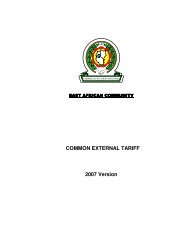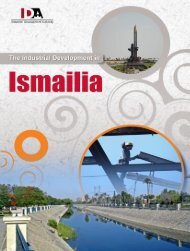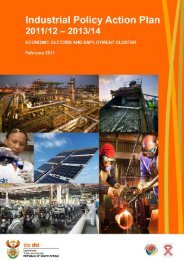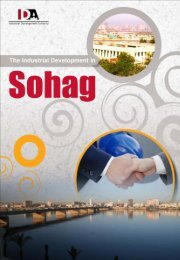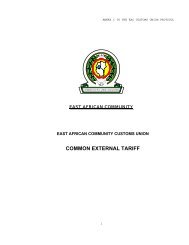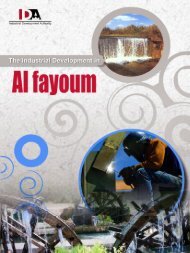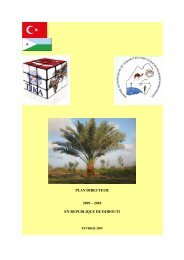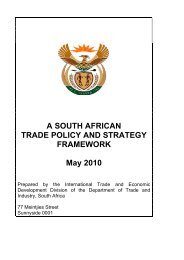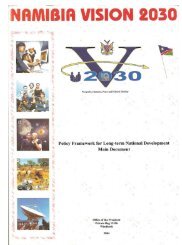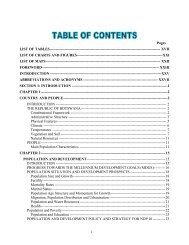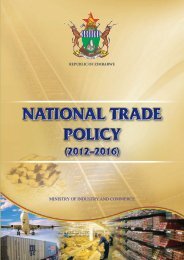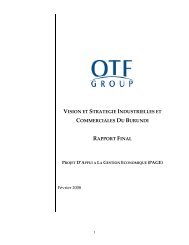rwanda national export strategy - minicom
rwanda national export strategy - minicom
rwanda national export strategy - minicom
Create successful ePaper yourself
Turn your PDF publications into a flip-book with our unique Google optimized e-Paper software.
Figure 5: Scoring for Priority Export Sectors<br />
Potential<br />
Export<br />
Contribution<br />
Job<br />
Creation<br />
RWANDA NATIONAL EXPORT STRATEGY<br />
Number of<br />
Existing<br />
Firms/Coops<br />
Market<br />
Attractiveness<br />
Existing<br />
Skill Base<br />
Relative to<br />
Competitors<br />
Opportunity<br />
for<br />
Differentiation<br />
Investor<br />
Prospects<br />
Weighting<br />
levels:<br />
x5 x2 x4 x2 x3 x2 x2 100<br />
Tourism 5 4.5 5 4.5 3 5 5 92<br />
Tea 5 5 3 5 5 4 4 88<br />
Coffee 5 5 3 5 5 4 3 86<br />
Mining 5 4 3 5 1 3 5 74<br />
BPO 5 4 2.5 4.5 2 2.5 5 73<br />
Horticulture 3.5 5 4 4 3 3 3 73<br />
Home Décor<br />
& Fashion<br />
2 5 5 4 2 5 2 68<br />
Dairy 3 5 2 2 4 1 3 57<br />
Hides &<br />
Skins<br />
3 3 2 3 2 2.5 3 52<br />
Floriculture 3 4 1 2 3 2 3 50<br />
Silk 2 3 2 3 3 3 2 49<br />
Pharma 4 2 1 3 1 2 3 47<br />
Scoring: 1 = Very Challenging, 2 = Somewhat Challenging, 3= Neutral, 4 = Attractive, 5= Very Attractive.<br />
There is a clear dividing line in the scores attained by sectors, with six in particular scoring 73 and above<br />
(out of 100). Whilst scoring seventh best in the rankings, Home Décor & Fashion was recognized to have<br />
strong growth potential, significant social benefits, and can support country branding. The global market<br />
for home décor and fashion is over US$250 billion annually, and in Rwanda, it is an extremely dynamic<br />
industry involving thousands of players, with several handling large <strong>export</strong> orders. As a result of this and<br />
significant stakeholder support for the sector, Home Décor & Fashion is included as a sector meriting<br />
targeted actions within the NES.<br />
4.3.1 TOURISM<br />
Rwanda‘s tourism sector has been exceeding expectations and is Rwanda‘s top foreign exchange earner.<br />
However, the industry requires ―game changer‖ activities and investments to leap frog towards becoming<br />
a truly world-class and high-demand tourism destination. Plans are being developed to add to the gorilla<br />
product, diversify into new products and experiences (cultural, conference and birding tourism), and<br />
target specific customer segments (Explorers, Eco-travellers and business travellers). In 2009, in<br />
conjunction with UNWTO, the tourism workgroup developed a new tourism master plan that sets the<br />
direction for the industry by setting revenues targets from US$186M in 2008 to US$627M by 2020. In<br />
2010 the sector recorded revenues of US$200M. Further, plans are being developed for adding additional<br />
events and conferences on a year-round basis, to attract more tourists.<br />
Rwanda‘s natural attractions need to be leveraged through investments in the potential experiences in<br />
these locations. Along with maximizing the use of Rwanda‘s natural resources, product diversification is<br />
essential to the continued growth of the tourism industry. Development of business tourism, cultural and<br />
religious tourism, and creating an events-based tourism are among the ways in which Rwanda can<br />
continue to grow its tourism revenues and meet the targets for 2020. However, customer service and<br />
associated training is required to launch Rwanda‘s tourism experience to world-class levels.<br />
Total<br />
Score<br />
(0-<br />
100)<br />
Page 30



